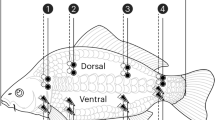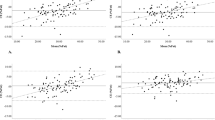Abstract
Background/objectives:
Traditional tetrapolar bioimpedance spectroscopy (BIS) is performed with the participant supine for 10 min. New vertical analyzers are penetrating clinical, home and fitness markets, but have body water values that differ from supine reference measures. The minimum time standing prior to assessment does not appear in the literature. We investigated the time course of body water shifts in healthy adults undergoing 30-min assessments in supine and vertical positions.
Subjects/methods:
While seated, participants were prepped for standard tetrapolar electrode placement. Starting position was counterbalanced and body water measurements were taken every 5 min for 30 min in both positions. Participants sat for 2 min prior to switching positions. Of the 64 participants, three were unable to stand for 30 min; their data were excluded. Body size differences were minimized via computation of relative (%) change between time intervals for total body water (TBW), extracellular water (ECW) and intracellular water (ICW).
Results:
ECW and ICW shifted in opposite directions while participants were supine; as ECW decreased at each time point, ICW increased (P<0.0125). Likewise, when participants stood, ECW increased incrementally (P<0.0125), but the decreases in ICW were not significant. At each time interval, the changes in supine ECW and ICW differed from the standing values (P<0.05). No postural or time differences were found for %change TBW.
Conclusions:
For TBW, 5 min appears sufficient for fluid stabilization in either position. Supine ECW and ICW stabilization require more than 30 min as does standing ECW.
This is a preview of subscription content, access via your institution
Access options
Subscribe to this journal
Receive 12 print issues and online access
$259.00 per year
only $21.58 per issue
Buy this article
- Purchase on Springer Link
- Instant access to full article PDF
Prices may be subject to local taxes which are calculated during checkout



Similar content being viewed by others
References
Wang ZM, Pi-Sunyer FX, Kotler DP, Wielopolski L, Withers RT, Pierson RN Jr et al. Multi-component methods: evaluation of new and traditional soft tissue mineral models by in vivo neutron activation analysis. Am J Clin Nutr 2002; 76: 968–974.
Kraemer M . A new model for the determination of fluid status and body composition from bioimpedance measurements. Physiol Meas 2006; 27: 901–919.
DeLorenzo A, Andreoli A, Matthie J, Withers P . Predicting body cell mass with bioimpedance by using theoretical methods: a technological review. J Appl Physiol 1997; 82: 1542–1558.
Earthman C, Traughber D, Dobratz J, Howell W . Bioimpedance spectroscopy for clinical assessment of fluid distribution and body cell mass. Nutr Clin Pract 2007; 22: 389–405.
Diouf A, Gartner A, Dossou NI, Sanon DA, Bluck L, Wright A et al. Validity of impedance-based predictions of total body water as measured by 2H dilution in African HIV/AIDS outpatients. Br J Nutr 2009; 101: 1369–1377.
Ellis KJ, Wong WW . Human hydrometry: comparison of multifrequency bioelectrical impedance with 2H2O and bromine dilution. J Appl Physiol 1998; 85: 1056–1062.
National Institutes of Health. Bioelectrical impedance analysis in body composition measurement: National Institutes of Health Technology Assessment Conference Statement, December 12-14, 1994. Amer J Clin Nutr 1994; 64 (suppl), 524S–532S.
Peterson JT, Repovich WES, Parascand CR . Accuracy of consumer grade bioelectrical impedance analysis devices compared to air displacement plethysmography. Int J Exerc Sci 2011; 4: 176–184.
Gibson AL, Holmes JC . Comparison of body water compartment values from a diverse adult sample using vertical and supine BIS analyzers. Int J Body Comp Res 2011; 3: 101–110.
van Marken Lichtenbelt WD, Snell YEM, Brummer RTJ, Koppeschaar HPF . Deuterium and bromide dilution, and bioimpedance spectrometry independently show that growth hormone-deficient adults have an enlarged extracellular water compartment related to intracellular water. J Clin Endocrinol Metab 1997; 82: 907–911.
Heyward VH, Wagner DR Applied Body Composition Assessment, (2nd ed.), Human Kinetics, 2004.
Hanai T . Theory of the dielectric dispersion due to the interfacial polarization and its application to emulsions. Colloid Polym Sci 1960; 171: 23–31.
Chamney PW, Wabel P, Moissl UM, Muller MJ, Bosy-Westphal A, Korth O et al. A whole-body model to distinguish excess fluid from the hydration of major body tissues. Am J Clin Nutr 2007; 85: 80–89.
Woodrow G, Oldroyd B, Wright A, Coward WA, Truscott JG . The effect of normalization of ECW volume as a marker of hydration in peritoneal dialysis patients and controls. Perit Dial Int 2005; 25: 549–551.
Hagan RD, Diaz FJ, Horvath SM . Plasma volume changes with movement to supine and standing positions. J Appl Physiol: Respirat Environ Exercise Physiol 1978; 45: 414–418.
Harrison MH . Thermal stress and exercise on blood volume in humans. Physiol Rev 1985; 65: 149–209.
Kushner RF, Gudivaka R, Schoeller DA . Clinical characteristics influencing bioelectrical impedance analysis measurements. Amer J Clin Nutr 1996; 64 (suppl), 423S–427S.
Maw GJ, Mackenzie IL, Taylor NAS . Redistribution of body fluids during postural manipulations. Acta Physiol Scand 1995; 155: 157–163.
Scharfetter H, Monif M, Laszlo Z, Lambauer T, Hutten H, Hinghofer-Szalkay H . Effect of postural changes on the reliability of volume estimations from bioimpedance spectroscopy data. Kidney Int 1997; 51: 1078–1087.
Zhu F, Schneditz D, Wang E, Levin NW . Dynamics of segmental extracellular volumes during changes in body position by bioimpedance analysis. J Appl Physiol 1998; 85: 497–504.
Fenech M, Jaffrin MY . Extracellular volume variations during postural change measured by segmental and wrist-ankle bioimpedance spectroscopy. IEEE Trans Biomed Eng 2004; 51: 155–175.
Oshima Y, Shiga T . Within-day variability of whole-body and segmental bioelectrical impedance in a standing position. Eur J Clin Nutr 2006; 60: 938–941.
van Marken Lichtenbelt WD, Folgelhom M . Increased extracellular water compartment, relative to intracellular water compartment, after weight reduction. J Appl Physiol 1999; 87: 294–298.
Elwyn DH, Bryan-Brown CW, Shoemaker WC . Nutritional aspects of body water dislocations in postoperative and depleted patients. Ann Surg 1975; 182: 76–85.
Acknowledgements
We thank those who volunteered for this study. Partial funding for this project was provided by the University of New Mexico’s Research Allocation Grant, 2009–10.
Author information
Authors and Affiliations
Corresponding author
Ethics declarations
Competing interests
The authors declare no conflict of interest.
Rights and permissions
About this article
Cite this article
Gibson, A., Beam, J., Alencar, M. et al. Time course of supine and standing shifts in total body, intracellular and extracellular water for a sample of healthy adults. Eur J Clin Nutr 69, 14–19 (2015). https://doi.org/10.1038/ejcn.2013.269
Received:
Revised:
Accepted:
Published:
Issue Date:
DOI: https://doi.org/10.1038/ejcn.2013.269
Keywords
This article is cited by
-
Cardiovascular responses to orthostasis during a simulated 3-day heatwave
Scientific Reports (2022)
-
The influence of body position on bioelectrical impedance spectroscopy measurements in young children
Scientific Reports (2021)
-
Cross-sectional and longitudinal agreement between two multifrequency bioimpedance devices for resistance, reactance, and phase angle values
European Journal of Clinical Nutrition (2020)
-
Influence of acute consumption of caffeine vs. placebo over Bia-derived measurements of body composition: a randomized, double-blind, crossover design
Journal of the International Society of Sports Nutrition (2018)
-
Effects of procedure, upright equilibrium time, sex and BMI on the precision of body fluid measurements using bioelectrical impedance analysis
European Journal of Clinical Nutrition (2018)



